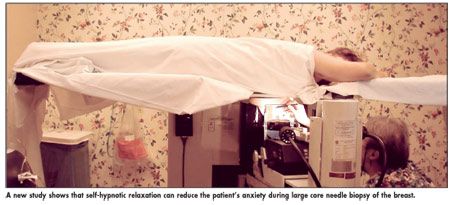Self-Hypnosis Reduces Anxiety During Breast Biopsy
A mind-body technique known as self-hypnotic relaxation performed during certain medical procedures significantly reduces pain, anxiety, drug use, and complications.
BOSTONA mind-body technique known as self-hypnotic relaxation performed during certain medical procedures significantly reduces pain, anxiety, drug use, and complications, Elvira V. Lang, MD, of Harvard Medical School and Beth Israel Deaconess Medical Center, Boston, said in her keynote address at the Society for Integrative Oncology's Third International Conference.
Even though general anesthesia is usually not required for minimally invasive procedures, patients can still experience some level of discomfort. Most physicians rely on IV narcotics and sedatives to manage pain and anxiety. However, side effects may occur with oversedation. An approach that reduces the discomfort without relying on IV drugs is needed.

In two randomized trials, the scientists compared the pain and anxiety of patients who received guidance in self-hypnotic relaxation on the procedure table with patients who received standard care (IV narcotics and sedatives).
First Randomized Trial
The first randomized trial, published in The Lancet (355:1486-1490, 2000), included 241 patients undergoing procedures that involved placing catheters and/or devices such as balloons through small skin openings into the blood vessels or kidneys for diagnosis or relief of blockages. The patients were divided into three treatment groups: standard IV sedation drugs (70 patients), "structured attention or empathy" (80 patients), and "self-hypnotic relaxation or hypnosis" (82 patients). All the treatments were done during surgery, and the patients were free to request pain medicine.
In the standard-care group, the nurses attended to the patients according to hospital practices and did their best to comfort them. The care providers in the structured attention group had been previously trained to follow eight key behaviors standardized in a treatment manual, including listening atten-tively;avoiding negative suggestions (Don't say "How bad is your pain?" rather "What are you experiencing?"); providing the perception of control ("Let us know at any time what we can do for you"); swiftly responding to patients' requests; and encouraging patients by commenting on something they do well ("Thanks for lying so still because that helps us go forward with the procedure").
Patients in the hypnosis group received all of the attention received by the empathy group and in addition were read a standardized hypnotic induction script. Using this script, patients are instructed to roll their eyes upwards, close their eyes, breathe deeply, and concentrate on a sensation of floating. They are guided to imagine a safe and comfortable place and are then prompted at various times to describe how they're feeling. If they're in pain or anxious, the care provider guides them to return to a favorite, comfortable spot, or to add coolness to the pain, or to focus on another part of their body.
During the procedure, the patients were asked every 15 minutes to evaluate their level of pain and anxiety on a scale of 0 to 10. The results showed that the pain increased with time in the standard group, and to a lesser degree in the empathy group, but remained constant over time in the hypnosis group. Anxiety decreased in all three groups, but the degree of decrease for the hypnosis group was significantly greater than for the standard-care patients.
Patients in the standard group received twice as many drugs as the other two groups. The average procedure time for the hypnosis group was significantly shorter than for the standard group (61 minutes vs 78 minutes) with the empathy group in between (67 minutes). In addition, a cost analysis found that the cost of standard care was $638 per patient vs $300 for the hypnosis group.
Breast Biopsy Study
The second randomized trial (Pain 126:155-164, 2006) tested the same interventions with 236 women undergoing large core needle breast biopsy. Again, patients were divided into three treatment groups and asked to rate their level of pain and anxiety at 10-minute intervals on a scale of 1 to 10.
The researchers found that anxiety increased significantly in the standard-care group, did not change in the empathy group, and decreased significantly in the hypnosis group. Pain increased significantly in all three groups, though less steeply with hypnosis and empathy than with standard care. There were no significant differences in side effects or time for the procedure. "This is a very stressful procedure for most women," Dr. Lang said. "But, within a few minutes, you can make a very big difference for these women, and you have given them a technique they can use on their own."
Dr. Lang is leading another randomized trial using relaxation therapy. This time the three treatments will be tested on patients who had catheters inserted into the blood vessels of either benign uterine tumors or malignant liver tumors to block the tumor's blood supply. Another group of patients in the trial had radiofrequency probes inserted directly into their tumors to destroy them by heat. In a preliminary analysis, Dr. Lang found that hypnosis significantly reduced pain, anxiety, drug use, and complications.